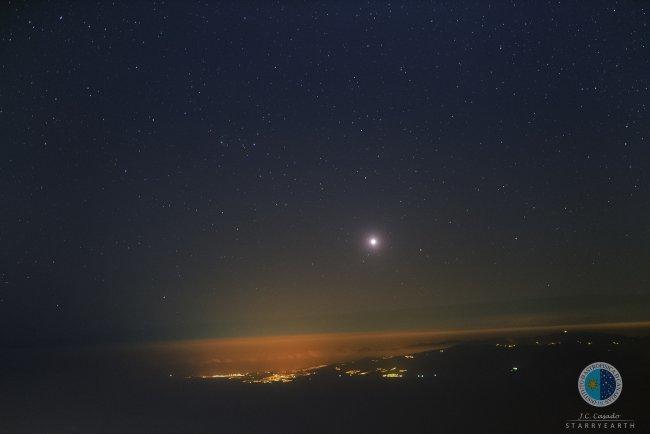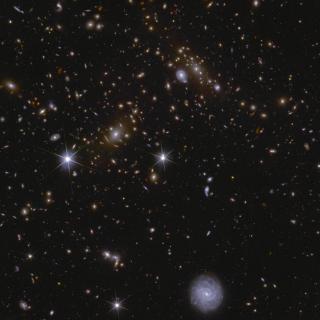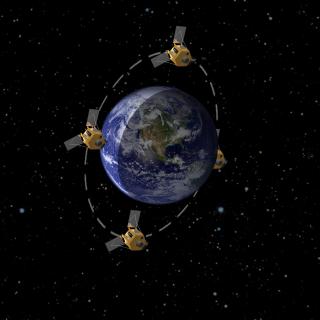Following the beautiful show which Lovejoy gave us just over a year ago (see images and videos) another comet, Catalina C/2013 US10 (Catalina in the rest of this press release) is visiting us for Christmas. Catalina is special comet, and very interesting for astronomers for a number of reasons. It is a new comet which lived in the Oort Cloud (a spherical cloud of rocks and dust which surrounds the Solar System at about one light year away from the Sun), and due to a gravitational "push" given by some nearby star, fell towards the inner Solar System. The dynamical calulations show that it has passed its perihelion travelling at high velocity, and so it will escape from the Sun's gravitational field out into interstellar space (see orbita). It is a wanderer which carries information about the initial stages of our solar system. We have only a couple of months to get to know it.
A similar campaign was organized to observe Lovejoy. Thanks to the images obtained at the Teide Observatory (IAC) we know that comet Lovejoy's day lasts approximately 18 hours (Serra-Ricart & Licandro, 2015ApJ, 814, 49S).
Who discovered Catalina?
Catalina was discovered on October 31st 2013 by the asteroid search programme Catalina (Catalina Sky Survey).
What is a comet?
A comet is an object in our solar system made up, mainly, of ice and dust, so that comets have been nicknamed "dirty snowballs". The comets move around the sun on very elliptical orbits, with periods of rotation around the Sun which vary from a few years to thousands of years. When they are at their nearest to the Sun (perihelion) its heat melts the cometary ices, and they emit gases and dust particles which form the tail (or tails) of the comet. A tail can be a million kilometres long (see Fig. 3)
The solid part of a comet is called its nucleus, and they have sizes between 10 km and 40 km. Most comets come from the Oort Cloud (a spherical cloud of rocks and dust situated at about one light year from the Sun) although some of them come from the Kuiper Belt (a disc of material at between 7,500 and 15,000 million kilometres from the Sun) and they normally have short periods (less than 200 years). The study of comets is very interesting for astronomers because they are fossils left from the period of formation of our solar system, and therefore contain information about the birth of planetary systems. If, in addition, the comet comes from the Oort Cloud (as does comet Catalina) the scientific interest is greater because they are usually new comets, which contain primordial material (material not processed by passage through planets) from the original cloud (the Solar nebula) from which our solar system formed.
What are the main characteristics of comet Catalina?
Comet Catalina is a comet originating in the Oort Cloud and it is the first time it has visited us. The most recent calculations suggest that it has a hyperbolic orbit, and so it will visit us only once. Catalina will abandon the Solar System after its passage through perihelion (its nearest point to the Sun). The last visible comet to visit us was comet Lovejoy (see the IAC press release).
Orbital characteristics
1) The closest approach to Earth (perigee) will be on 17th January 2016, when it will be at 108 million kilometres from us (the mean Earth-Sun distance is 150 million kilometres) 2) The closest approach to the Sun (perihelion) was on 15th November 2015, at a distance of 123 million kilometres.
In the Table below we compare the characteristics of Catalina and Lovejoy
Name | Discovery date | Perihelion date | Perigeo Perigee Date |
Lovejoy C/2014 Q2 | 17/08/2014 | 30/01/15 (193 Mkm) | 07/01/15 (70 Mkm) |
Catalina C/2013 US10 | 31/10/2013 | 15/11/15 (123 Mkm) | 17/01/16 (108 Mkm) |
How to observe it?
Since the beginning of December 2015 the comet has been visible in the northern hemisphere in the early morning. From the first week in January, coinciding with the reduction in the Moon's brightness (new Moon will be on January 10th) conditions for observing the comet will be at their best. It will be visible from midnight until sunrise. The key point is to be in dark surroundings. We need a sky map to find the position of Catalina because its position in the sky varies day by day due to its orbital motion.
Sky map to locate Catalina
http://www.skyandtelescope.com/wp-content/uploads/Web_Dec15_Catalina.pdf
It should be possible to pick out the central zone of the comet with the naked eye (see Figure 1), while to observe more detail it is preferable to use some modest binoculars. As the comet comes from the Oort Cloud it is not easy to predict how its brightness will evolve. The latest predictions suggest that it will reach a magnitude +5 (just visible to the naked eye) at mid-January, the best time to observe it because it will be found in the constellation of the Plough between the stars Mizar and Alkaid (see the map)
Audiovisual material
Orbits of Catalina and Lovejoy (https://youtu.be/qLZellwjxlc)
Images of Catalina.



